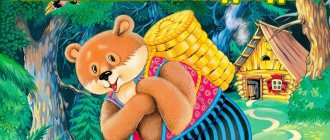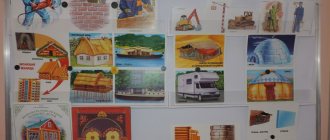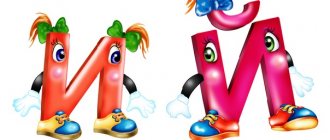NOD “Telling the Russian folk tale “Masha and the Bear” (junior preschool age)
Shpiyakina Natalya Viktorovna
NOD “Telling the Russian folk tale “Masha and the Bear” (junior preschool age)
Municipal state preschool educational institution of the city of Novosibirsk “Kindergarten No. 478 of a combined type”
.
Direct educational activities on the topic:
" Telling the Russian folk tale " Masha and the Bear "
.
Junior preschool age (3-4 years)
.
Compiled by: teacher of MKDOU
"Kindergarten No. 478 combined type"
first qualification category
Shpiyakina Natalya Viktorovna
Introduce children to the Russian folk tale " Masha and the Bear "
Teach children to emotionally perceive a fairy tale , memorize and intonationally expressively reproduce words and phrases from the text.
In a playful, entertaining way, consolidate children’s knowledge on the lexical topic “Clothing”
.
Activate and expand your vocabulary.
Enrich the experience of listening to literary works.
Develop the ability to perceive text and, with the help of an adult, understand the content.
Develop the ability to finish words and phrases, answer questions about a fairy tale .
Develop dialogical speech.
Develop attention, memory, initiative, thinking.
Create a joyful mood in children.
Cultivate in children an interest in reading literary works.
To educate children’s culture based on improving practical skills.
Use of ICT. Literary word, situational tasks, conversation, use of visuals, appeal to children’s life experiences. Phys. minute “We walk through the forest together”
.
Game "Mashenka's preparations for the journey
.
Multimedia PowerPoint presentation with illustrations from the Russian folk tale " Masha and the Bear "
, multimedia presentation in PowerPoint with illustrations of summer clothes, paper dolls
(2 pieces)
and clothes for the game episode
“Mashenka’s preparations for the journey
.
Integration of educational areas:
NGO "Social and communicative development"
(Game
“Mashenka’s Packing for the Road”
, NGO
“Cognitive Development”
(conversation about clothes, NGO
“Speech Development”
(conversation on
the Russian folk tale “
Masha and the Bear ” , NGO
“Artistic and Aesthetic Development”
(introduction to
the Russian folk tale “
Masha and the Bear " , NGO
"Physical Development"
(Physical minute
"We walk through the forest together"
).
Abstract of joint activities:
Children sit on chairs. The teacher invites them to get acquainted with the Russian folk tale “ Masha and the Bear ”
.
The teacher tells a fairy tale colorful illustrations
as he tells it After getting acquainted with the Russian folk tale " Masha and the Bear "
, the teacher invites the children to take a walk in the forest.
Conducts a physical exercise “Let’s walk through the forest together
.
After physical exercise, the children sit on chairs. The teacher conducts a conversation based on the fairy tale " Masha and the Bear "
.
Talks about new, unfamiliar words found in fairy tales , shows illustrations.
After the conversation, the teacher invites the children to act out the episode “Mashenka’s preparations for the journey”
, having previously remembered what clothes you can wear in the summer.
The teacher chooses 2 children. Invites the children to choose things for Masha and dress her up. To do this, the teacher invites the children to the table on which paper dolls and clothes are placed. The teacher can lay out not only summer clothes, but also add winter clothes to confuse the children. Children must choose the right summer clothes for Masha. The rest of the children suggest and help.
After the game, the teacher talks with the children and sums up the joint activity.
Progress of the lesson:
Do you want to hear what happened to one little girl who got lost in the forest? Then listen to the fairy tale " Masha and the Bear "
.
The teacher reads a fairy tale , showing illustrative material as the reading progresses.
Educator: tell me how Mashenka went into the forest.
— What did the bear say when he returned home? (Children's answers)
— What did Mashenka come up with to outsmart the bear ? (Children's answers?
— Where did grandparents find their Mashenka? (Children's answers)
Physical education lesson: game “Blow up your bubble”
.
Educator: Guys, let's play a fairy tale ! But first, let's remember what the bear when he was carrying the box?
Children: I’ll sit on a tree stump and eat a pie.
Educator: What did Mashenka answer?
Children: I see, I see, don’t sit on the tree stump, don’t eat the pie, bring it to grandma, bring it to grandpa!
1. At will, Masha and the bear , the scene of how the bear collects a box .
2. Another pair of heroes is chosen to improvise how Masha cleaned up the bear in the hut and his return home from the forest, the first meeting of the heroes.
3. Choose grandmother, grandfather, bear and Masha . A scene of how the grandfather and woman cried, and the bear brought a box with his granddaughter. Surprise moment: The rest of the children are offered the role of the dogs that chased the bear . Children chase a bear in a circle around the “village”
.
Reflection: guys, is it a good fairy tale ? (children's answers)
.
Which characters did you like the most? (children's answers)
.
See you soon in a new fairy tale !
Case technology. Russian folktale. Case technology is a technology for studying phenomena based on specific situations. The essence of technology is the study of general patterns.
Summary of direct educational activities on FEMP. Russian folk tale “Geese and Swans” in the middle group Russian folk tale “Geese and Swans” in the middle group “Daisies.” Educator: Sovkova M.A. MDOU Kindergarten No. 5 “Fairy Tale” b. n. Ozinki.
Summary of GCD for familiarization with fiction. Russian folk tale "Sivka-burka". Senior preschool age Objectives: Cognitive development: introduce children to the Russian folk tale “Sivka-Burka”, give children an idea of the origin of Russians.
Summary of an open lesson on speech development in the senior group “Russian folk tale “Khavroshechka” Summary of an open lesson on speech development. Russian folk tale “Khavroshechka” Purpose: To recall Russian folk tales known to children.
Musical fairy tale “How Masha and the Bear became friends” (for children) Characters: Adult role: Storyteller Children's roles: Baba Nastya, Grandfather Fedot, Masha, Girlfriend's cars, Doggie, Cat, Bear, Bunny, Wolf,.
Russian folk tale “Kolobok” (middle group) Author: Once upon a time there lived an old man and an old woman. (They go out and sit on the bench) Grandfather: Grandma, bake us a bun. Grandma: What will I bake it with? Flour.
Fairy tale for the puppet theater “Masha and the Bear” Introductory music plays. The buffoon appears. Buffoon. Well, hello funny people! Skomorokh and Skomoroshka are coming to visit you.
A fairy tale in a new way “Masha and the Bear” to automate the sound [w] “Masha and the Bear” Russian folk tale in a new way Goal: automation of the sound [w] in open syllables and syllables with a combination of consonants.
Source
Summary of educational activities for speech development in the second group of early age “Reading the fairy tale “Masha and the Bear”
Antonina Khristoforova
Summary of educational activities for speech development in the second group of early age “Reading the fairy tale “Masha and the Bear”
Summary of educational activities for speech development in the second group of early age.
Reading the fairy tale " Masha and the Bear "
.
1 Educational objectives: Introduce children to Russian folk tales .
2. Developmental tasks : To develop children’s ability to listen to a fairy tale , to empathize with the heroes of the fairy tale .
3. Educational objectives: To instill interest in Russian folk tales .
Equipment: Book “ Masha and the Bear ”
, toy - bear.
GCD lesson notes. Russian folk tale "Masha and the Bear"
Victoria Ilyina
GCD lesson notes. Russian folk tale "Masha and the Bear"
Lesson notes for GCD Introducing preschoolers to literature and folklore, second junior group.
Russian folk tale " Masha and the Bear "
.
- teach to emotionally perceive a fairy tale ;
- remember and intonationally expressively reproduce words and phrases from the text in the process of theatricalization;
- teach, with the help of a teacher, to select props, choose means of expression for staging and dramatizing excerpts from works of oral folk art ;
- learn to evaluate the actions of characters and their consequences, to understand the motives of the characters at an elementary level;
Integration of areas: speech development, artistic and aesthetic development, social and communicative development.
Equipment: book with the fairy tale “ Masha and the Bear ”
a bear head mask , chairs, backpack (box, large construction kit (pies)
.


